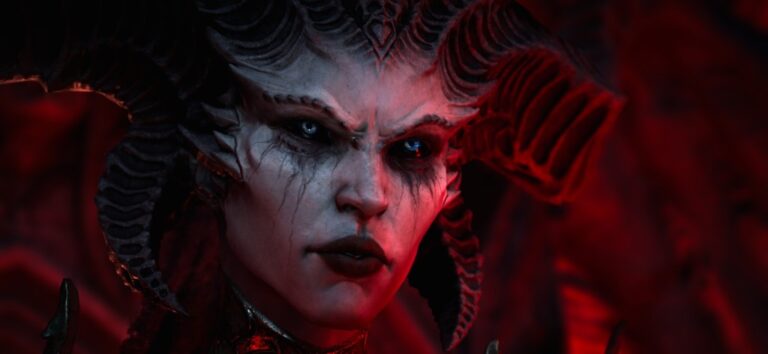Diablo IV has a very anticlimactic ending that may leave you scratching your head if the game is really over or what has occurred. It may not make a lot of sense at first, but there’s a few things at play when it comes to the ending. We’ll go first over the ending itself literally then take a figurative look at what all of this means for Sanctuary.
Quick Note: For the backstory on Lilith, Inarius and Sanctuary see sort of “Part 1” which goes over the events before the game. We’re going to dive right into the ending, which kicks off towards the very end of Diablo IV.

How Does Diablo IV End?
Inarius and Lilith were both, from the player character’s point of view, insane from their time exiled. Inarius had been in hell for a few millennia per Lorath (which holds the canon from the books still) and Lilith would have been exiled even longer. This drives the major plot of the game forward, as Lilith ravages the world to seek a way back into Hell and Inarius so obsessed with a prophecy that he refuses to intervene to ensure that the prophecy is fulfilled so he can return to the High Heavens.
So focused on the prophecy, he founds the Cathedral again and sits around allowing Lilith to do as she pleases throughout the game. That is until the last part of the game, when Lorath makes a deal with the Tree of Whispers to find out where Lilith actually is: on her way to Hell to seize Mephisto’s power. Why was Lilith wanting to seize Mephisto’s power? That’d make her the strongest demon prime evil and allow her to protect Sanctuary, no matter what. (Mephisto is sort of respawning right from the events of Diablo III).
So all the entire story you’re always where she just was, but you now know where she is: Caldeum with the key to the Hell Gate located there. The part including Donan, Neyrelle, Lorath and the “wanderer” (Diablo IV’s wanderer) make their way to Caldeum where they meet the Cathedral’s army which has seiged and taken the city and making their way through the Hell Gate.
Inarius tells the group that they’re not needed (again, he only cares about the prophecy so he can return to the High Heavens). Lorath has Donan hand over the soul stone and Inarius departs. This was given to Prava, who the group meets up with and follows through the Hell Gate into Hell.

Inarius vs. Lilith
Following the prophecy, Inarius fights Lilith and jams his spear through her chest. Outside his army is holding fast against wave after wave of demons. After winning the fight, Inarius gets no response from the High Heavens and Lilith reminds him that he will only ever be met with silence no matter what he does. She then kills him, but his wound did indeed weaken her.
Mephisto’s Meddling in Diablo IV
Here’s where things become very vague. From the start of the game, the main character is saved by Mephisto in wolf form at the start. The character then travels to a village, where they’re given the blood of Lilith linking the two together. From there Mephisto is manipulating events so that the player character stops Lilith, even if Lilith logically provides them more evidence that she’s far more aligned to the Human’s agenda.
Lorath brings the sightless eye relic along with them into Hell and has the main character (I don’t like using wanderer because that’s also Diablo from Diablo II) use it. They find Lilith working with Astaroth (who is Astaroth? just a demon who can open the path to where Mephisto is at) and Lilith, being someone who knows that ancient relic inside and out, traps the main character in their own mind.
Lilith at this point is planning to recreate Sanctuary, something that probably wouldn’t be a good thing for Humans. Given her idea of freedom is, um, yeah. The side quests in the game give you a really strong idea of what freedom is. Her cultists do some very wild things that are uh very wild?
Back to the mind prison, Lilth is offering the main character a chance to join her and help her save Sanctuary. Since that’s probably not a good thing, Mephisto shows up and offers an escape out since Lilith won’t let you free without agreeing to join her. Mephisto, being the strongest prime evil, is probably not to be trusted in any capacity either.
Escaping the mind prison with Mephisto’s help, the party is reunited to a Dolan who dies.
Defeating Lilith and Freeing Mephisto
Back with the group, Neyrelle and the main character go through a portal directly to Mephisto. It’s right where he’s currently reforming from the events of Diablo III. Neyrelle decides to have an arugment about who they should use the soul stone on. If they use it on Lilith, Mephisto remains and is currently reforming still.
It’s decided that Neyrelle will use the soul stone on Mephisto and flee with him. Instead of both of them fleeing, the main character stays and confronts Lilith. They then defeat Lilith, anticlimactically at that, then return to find Neyrelle gone and Lorath ready to leave.
Returning back to the chapel, Neyrelle is nowhere to be found. Going to the vault, Neyrelle leaves a letter explaining that there has to be some other way. A cutscene plays out showing Neyrelle journeying with the soul stone, though giving no details on what she is planning to do or where she’s going. That concludes the story of Diablo IV’s campaign and opens the player up to doing chores for the tree and capstone dungeons to level up the world tier.
Oh and Iosef dies. Just he dies. He comes to kill Lorath and then you kill them. That’s pretty much the last quest quest you do as part of the official story. So the nice monk from the start just basically announces the Cathedral isn’t really your friend.
Why the Inconclusive Ending Without Diablo
Ultimately Diablo IV is a story about chasing Lilith and killing her before she does any harm to Sanctuary. She ends up, in her wake, taking out Caldeum along with several smaller villages in a world that’s been left in ruins after the events of Diablo III. Sanctuary already was a pretty bad place, but Diablo III leaves it basically with Tristram not being that rare of an event anymore.
You get the conclusion to Lilith’s story and the rest of it is coming as Diablo IV’s live service updates and additional content drops. Much of the game is designed around something like The Division where there’s a campaign that you can do and then after the campaign there’s special quests that unlock, same story here.
It’ll also work very likely like Destiny, where the story continues in various seasons of new content (hence the season pass). The conclusion to the campaign is the start to much more.
As far as Diablo, it’s very odd he’s not around. He’s available to be around, just as Mephisto.
Tree of Whispers
The endgame of Diablo IV is doing quests for a tree. The tree is indeed new to Diablo IV. It basically holds the memories of everyone who has made a deal with it, making it very knowledgeable. The issue is, when you perish, a crow will come to take your head and add it to the tree. Elias made this deal to learn how to bring Lilith into Sanctuary and then bound his soul to a finger and placed it into the depths, a dungeon the tree can’t really reach. This is why the tree was angry with Elias.
Lorath made a deal, but since it’s when you perish, he keeps his head for now. The main character hasn’t made the deal, but like Terissa, is working on behalf of the tree.
It makes zero sense why the tree doesn’t care about Sanctuary a whole lot and only its debts.
Ending FAQ
- Do you fight Mephisto? No. You fight only Andariel and Duriel from the lesser evils.
- Why do you fight Duriel? Good question, Duriel is sort of just there. It’s the desert and you’re entering hell through there, so maybe that’s why. Anyway, it’s Duriel.
- Where is Tyrael? No clue, he’s referenced in flavor text but nowhere to be around. Deckard Cain makes a brief cameo in a flashback. He’s not brought back. Meshif dies thinking Lothar is Deckard.
- Where are the Nephalem? Are you a Nephalem? The game doesn’t really delve back into the Diablo III Nephalem lore. The Nephalem issue still remains: the world stone doesn’t exist to check their power. Your character is likely a Nephalem, but again nothing is mentioned. There are no Diablo III main character cameos in the original campaign.
- Why did Caldeum fall? They closed their gates after Diablo III and if Lilith just kind of shows up, weak minds are easily influenced by her demonic power.
- Who is good and bad? Wew this game just doesn’t care about that. Inarius and Lilith are both bad in the sense that neither want to do true good for Sanctuary and just want to like make up for their mistake of making it now the World Stone is gone. Mephisto is just, who knows what he wants. Again, without the stone these people just aren’t that into Sanctuary except for its military potential of the Nephalem and the potential threat they serve.
- Who is the Cathedral of Light? They’re from the Sin War. It was an organization Inarius made back then. He brought it back.
- Was Lilith good? Not really, no. Lilith was a demon who wanted to remake Sanctuary. Without the side quests you really don’t get the disdain the characters have for her and waht her cultists do. Inarius isn’t much better just less I guess gross about it.
- Do you have to do the campaign? Can you skip it? To skip the campaign, you first have to complete it on one character. Then when you make a new character you can choose “skip campaign.” The campaign is about ~25-30 hours long, while leveling to just 50 using our leveling guide would be about 15 hours.
Wrap Up
In conclusion, you defeat Lilith in Diablo IV. This prevents Lilith and Inarius from corrupting the world any further. Two lesser evils have been put back into their “void” state. The Tree of Whispers has hired the player to go out and do errands for it as the endgame. That’s basically the ending of Diablo IV!
More will come in future updates, but the core game that represents the story of Lilith’s return and her defeat by the wanderer.






